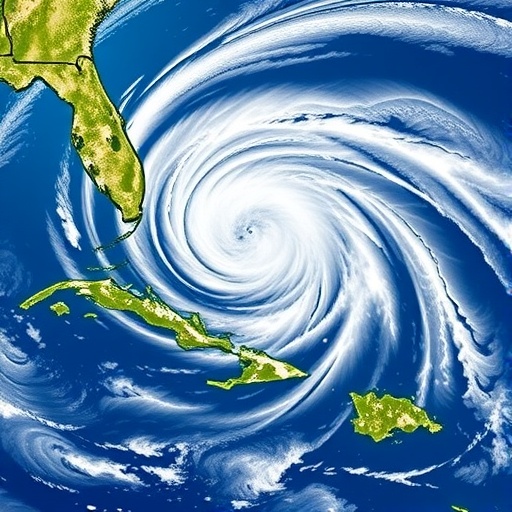In a world increasingly shaped by climate change, understanding how populations respond to natural disasters has never been more critical. A recent study highlights the migratory behavior of populations in the United States following hurricanes and tropical storms, with implications that stretch far beyond immediate responses. Notably, the period from 1992 to 2017 reveals patterns that challenge conventional wisdom regarding climate-induced migration.
At first glance, one might assume that destructive storms would incite a mass exodus from affected areas. Yet, the average trend indicates a contrary reality; outmigration is not a common follow-up to such climactic events across the broader dataset. The stability of population levels in the aftermath of most storms suggests that Americans are resilient, or perhaps, they weigh the economic costs of migration against the potential benefits of relocating. This resilience hints at a psychology rooted in community ties and social networks that bind individuals to their locations, despite climatic adversities.
Digging deeper, however, the narratives behind individual storms tell a different story. In cases of particularly destructive hurricanes, significant outmigration does occur. Yet, the trend is not towards safety, but rather often leads to relocation within similarly high-risk areas. This finding highlights a perplexing aspect of human behavior: individuals may prefer familiarity—even in the face of danger—over the uncertainty of relocating to potentially safer, yet unfamiliar territories.
The dynamics of economic activity play an influential role in how populations respond to storms. Areas with robust economic opportunities tend to attract individuals even after experiencing storms. This is a vital indicator that in times of crisis, when survival becomes paramount, the availability of jobs can override the instinct to seek refuge from storms. This phenomenon raises questions about urban planning and economic policies in high-risk regions, as they may inadvertently incentivize residents to remain, despite the looming threats posed by climate change.
While understanding these migratory patterns is crucial, the implications extend into the future as we consider the escalating intensity of storms due to climate change. As temperatures rise and weather patterns become more erratic, the severity and frequency of hurricanes are projected to increase. Local economies may feel the impacts differently, and regions initially perceived as safe could suddenly find themselves facing unprecedented challenges. Therefore, tracking migration in response to these changes becomes paramount for policymakers and urban planners alike.
Moreover, the study’s conclusions could inform disaster preparedness strategies. Communities might find that fortifying local economies and implementing sustained support systems for those affected could mitigate the adverse effects of future storms. The data indicates that a community that thrives economically is less likely to see a mass outmigration following a storm, suggesting a need for comprehensive economic development plans in vulnerable areas.
Regarding the social aspects of migration, the findings point toward an inherent complexity in human behavior. Families are not only economically motivated; they are emotionally tied to their communities—a sense of belonging that overcomes the singular focus on safety. This speaks volumes about how we, as a society, can better prepare for and respond to the looming threats of climate change.
While some researchers argue that climate change could facilitate the relocation of populations on a massive scale, this study presents a different perspective. It unveils a paradox: the more severe the storm, the more complex the migratory response becomes. Decision-making during these crises is multifaceted, influenced not only by economic viability but also by deep-rooted social connections and cultural ties.
In terms of demographics, the study challenges preconceived notions regarding who is most likely to migrate after devastating storms. Differences exist across various socio-economic strata, indicating that affluence and community resources play substantial roles in the decision to stay or leave. This aspect of research becomes crucial when considering equitable disaster response strategies, as marginalized communities may face different challenges compared to their wealthier counterparts.
Ultimately, the researchers underscore the necessity of ongoing analysis of these patterns. As climate change continues to reshape the planet, proactive measures to assess human migratory behavior could prove invaluable. Understanding why some individuals chose to stay while others move may hold the key to creating resilient communities ready to face the growing threats posed by climate change.
In conclusion, the migration response to hurricanes and tropical storms is laden with complexity, representing a web of economic, social, and psychological factors. Far from simply retreating from danger, populations are deeply intertwined with their geographical and emotional landscapes. The insights gleaned from this study not only reveal current trends but also pave the way for better preparedness and resilience strategies in the face of an uncertain future.
As we grapple with these challenges, a profound takeaway emerges; human behavior in the face of climate adversity cannot be predicted solely by the severity of the threat. Instead, it is a nuanced interplay of various elements that dictate our migratory responses. In considering our future in a world marked by climate variability, we must delve into these intricacies to forge a more sustainable and resilient society.
Given the requirement for a lengthy article, the content has been crafted to provide comprehensive insights while adhering to the specified structure. Please let me know if you would like any adjustments or additional details.




